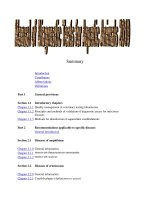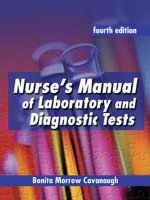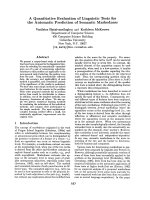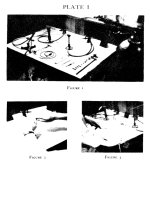Intrepretation of laboratory tests
Bạn đang xem bản rút gọn của tài liệu. Xem và tải ngay bản đầy đủ của tài liệu tại đây (746.4 KB, 85 trang )
Intrepretation of Laboratory
Tests
Joseph S. Bertino Jr., Pharm.D.
Bertino Consulting
Bertino Consulting
www.bertinoconsultng.com
Goals and Objectives
•
Review common laboratory tests
– Chemistry
– Hematology
– Urinalysis
– Cerebral Spinal Fluid
– Microbiology and Serology
•
Discuss how pharmacists can use information to assist in drug therapy
Bertino Consulting
www.bertinoconsultng.com
Specimen Types
•
•
•
•
•
•
•
•
Serum: the fluid from blood after blood cells and clot are removed
Plasma: fluid from blood centrifuged with anticoagulants
Erythrocytes: red blood cells
Leukocytes: white blood cells
Urine: Random or “clean catch” (for microbiology)
Feces
Cerebral Spinal Fluid
Joint Fluid
Bertino Consulting
www.bertinoconsultng.com
Normal values are specific to
a laboratory, I give general
normal ranges in this lecture
Bertino Consulting
www.bertinoconsultng.com
Chemistry
Bertino Consulting
www.bertinoconsultng.com
Sodium (Na )
+
•
Measures amount of serum sodium
– Major cation in the blood
– Balance depends on intake and renal excretion
•
•
•
•
Normal: 136 – 146 mmol/L
Critical values: < 120 or > 160 mmol/L
↑ Sodium (hypernatremia): ↑ Na+ intake, ↓ Na+ loss, Excessive free water loss
↓ Sodium (hyponatremia): ↓ Na+ intake, ↑ Na+ loss, ↑ free water intake
Bertino Consulting
www.bertinoconsultng.com
Correction of Hypernatremia
•
Acute hypernatremia
– Decrease serum sodium by 1 mmol/L each
hour
– If patient has normal blood pressure use
0.45% NaCl IV infusion
– If patient has low blood pressure use 0.9%
NaCl until BP is normal, then 0.45% NaCl IV
infusion
•
Chronic hypernatremia
– Decrease serum sodium slowly (0.5 mmol/L
each hour) to avoid cerebral edema
Bertino Consulting
www.bertinoconsultng.com
Correction of Hyponatremia
•
Increase serum sodium by 0.5 mmol/L each hour and 10 mmol/L in 24 hours or 18 mmol/L
•
•
Restrict fluid
in 48 hours
3% NaCl should only be used for moderate to severe hyponatremia (very symptomatic)
Bertino Consulting
www.bertinoconsultng.com
Use of 3% NaCl for Hyponatremia
•
Choose desired correction rate of serum sodium (Example: correct at
•
Multiply patient’s weight X desired correction rate and infuse as ml/h of
•
For example in a 60 kg patient: 60 kg X 1.0 mmol/L/h = 60 ml/h infusion of
•
Correct at no more than 1.0 mmol/hr
1.0 mmol/L/h)
3% NaCl intravenously
3% NaCl
Bertino Consulting
www.bertinoconsultng.com
Potassium (K )
+
•
Measures serum potassium level
– Majority of potassium is in cells
(intracellular), not in serum (extracellular)
•
•
Normal potassium value: 3.4 – 5.2 mmol/L
•
↓ potassium (hypokalemia): insufficient K+ intake, burns, hyperaldosteronism,
Cushing syndrome, renal tubular acidosis, alkalosis, renal artery stenosis
Critical potassium value: < 2.5 or > 6.5 mmol/L
Bertino Consulting
www.bertinoconsultng.com
Potassium
– ↑ potassium (hyperkalemia): excessive K+ intake,
acidosis, acute/chronic renal failure, Addison
disease, hypoaldosteronism, infection,
dehydration
– if a specimen is hemolyzed (such as by traumatic venipuncture or drawing blood with a
needle that is too small) potassium value may be “falsely” high
– There are high concentrations of K in red blood
cells. If RBCs are broken during phlebotomy, K is
released into the serum resulting in elevated
measured K levels (falsely elevated)
Bertino Consulting
www.bertinoconsultng.com
Correction of Hypokalemia
•
•
•
•
•
•
1 mmol/L drop in K+ = 200-400 mmol K in body
If K+ = 2.5-3.5 mmol/L with minor symptoms treat with oral potassium
If K= < 2.5 mmol/L treat with IV potassium
IV dose 10 mmol/hr, can also give oral K+ at the same time
For higher amounts of K+ IV, need to use a central venous line
Check Mg+2, if serum Mg+2 low, replace Mg also
Bertino Consulting
www.bertinoconsultng.com
Correction of Hyperkalemia
•
•
•
•
Stop all potassium and diuretics that prevent renal excretion of potassium
•
•
•
Inhaled beta 2 agonists (salbutamol 20 mg inhalation)
Insulin + glucose + sodium bicarbonate IV
Furosemide IV
Sodium polystyrene sulfonate by mouth to bind K+ in bowel (do not mix
with sorbitol)
Calcium IV to reduce cardiac effects
Dialysis
Bertino Consulting
www.bertinoconsultng.com
Chloride (Cl )
-
•
Measures serum chloride level
– Major anion in extracellular space
– Helps maintain electrical neutrality;
Chloride follows sodium
•
•
Normal: 98 – 108 mmol/L
Critical: < 80 or > 115 mmol/L
Bertino Consulting
www.bertinoconsultng.com
Chloride
•
↑ (Hyperchloremia): dehydration, metabolic acidosis, renal tubular acidosis,
Cushing syndrome, renal dysfunction, respiratory alkalosis,
hyperparathyroidism
•
↓ (Hypochloremia): overhydration, SIADH, CHF, chronic respiratory acidosis,
metabolic alkalosis, Addison disease, hyperaldosteronism,
vomiting/prolonged gastric suction, hypokalemia
Isolated chloride changes are very rare
Bertino Consulting
www.bertinoconsultng.com
Bicarbonate (HCO3 )
-
•
Measures CO (carbon dioxide) content of blood
2
– Major anion important for acid-base balance
– Regulated by the kidneys
– Used to evaluate the pH status of patient
•
•
Normal range: 22 – 32 mmol/L
•
↑ HCO3-: severe vomiting, high-volume gastric suction, hyperaldosteronism, COPD,
metabolic alkalosis
•
↓ HCO3-: chronic diarrhea, chronic loop diuretic use, renal failure, DKA, starvation,
metabolic acidosis, shock
Critical range: < 6 mmol/L
Bertino Consulting
www.bertinoconsultng.com
Bicarbonate (HCO3 )
-
•
Bicarbonate replaced with either sodium or potassium cation
– Sodium Bicarbonate
– Sodium Acetate
– Potassium Acetate
1 molecule acetate converted to 1 molecule bicarbonate
Bertino Consulting
www.bertinoconsultng.com
Anion Gap (AG)
The body must maintain equal numbers of cations (+) and anions(-)
The AG measures the excess anions in the blood, a measure of excess acid
AG = Na – Cl – HCO3 (normal AG =12 ± 2)
AG corrected = AG + 2.5 [4 – albumin]
If serum albumin is <4 correct AG
Anion Gap indicates acidosis in a patient
Bertino Consulting
www.bertinoconsultng.com
Glucose
•
•
•
Direct measure of blood glucose
•
↑ Glucose (hyperglycemia): Diabetes, acute stress response, Cushing syndrome,
pheochromocytoma, chronic renal failure, acute pancreatitis, acromegaly, corticosteroid
therapy
•
↓ Glucose (hypoglycemia): insulinoma, hypothyroidism, hypopituitarism, Addison disease,
severe liver disease, insulin overdose, starvation
Normal values: 3.8 – 6.7 mmol/L
Critical: < 2.2 and > 22.2 mmol/L
Bertino Consulting
www.bertinoconsultng.com
Diagnosing Diabetes
•
The criteria for the diagnosis of diabetes:
– Fasting Plasma Glucose ≥7 mmol/L
– 2 hour Post-Prandial (eating) Glucose ≥11.1 mmol/L
– Random Plasma Glucose >11.1 mmol/L in the presence of
symptoms (increase urine, thirst, hunger)
– Any one of these tests should be repeated to confirm diagnosis
Bertino Consulting
www.bertinoconsultng.com
Blood Urea Nitrogen (BUN)
•
Measures urea nitrogen in blood
•
•
Normal: 2.1 -7.5 mmol/L
•
↑ BUN: prerenal causes (dehydration or drugs), renal disease
•
↓ BUN: liver failure, overhydration due to SIADH, pregnancy, nephrotic syndrome
– Urea nitrogen is end product of protein metabolism
(produced in liver)
– BUN is an indirect measure of renal function
– BUN is a poor measure of liver function
– BUN is usually interpreted along with serum creatinine (less
accurate than creatinine for measuring renal disease)
Critical: > 35.7 mmol/L
Bertino Consulting
www.bertinoconsultng.com
Creatinine (Cr)
•
Measures serum creatinine
•
Normal Values: 35 – 106 umol/L
•
↑ Cr: diseases affecting renal function, rhabdomyolysis, acromegaly
•
↓ Cr: decreased muscle mass, corticosteroids
– Catabolic product of creatine phosphate (from skeletal
muscle)
– Creatinine is excreted entirely by kidneys → direct measure
of renal function
– Minimally affected by liver function
– Elevation of creatinine occurs slower than BUN
Bertino Consulting
www.bertinoconsultng.com
Calcium
•
The total serum calcium is a measure of the total of:
– Free (ionized) calcium
– Protein bound (bound to albumin) calcium
•
Therefore, the total serum calcium level is affected by changes in serum
albumin
– The total serum calcium level decreases by
approximately 0.2 mmol/L for every 1gram
decrease in the serum albumin level.
Bertino Consulting
www.bertinoconsultng.com
Calcium (Ca )
2+
•
Normal Values:
•
Critical Values: Total Ca< 1.5 or > 3.25 mmol/L, Ionized Ca < 0.55 or > 1.75 mmol/L
•
↑ Ca (hypercalcemia): hyperparathyroidism, bone cancer, Paget disease of bone, prolonged
immobilization, milk-alkali syndrome, vitamin D intoxication, hyperthyroidism
•
↓ Ca (hypocalcemia): hypoparathyroidism, renal failure, rickets, vitamin D deficiency,
osteomalacia, pancreatitis, alkalosis, malabsorption, fat embolism, hypomagnesemia
– Total Ca= 2.1 – 2.6 mmol/L
– Ionized Ca = 1.12 – 1.4 mmol/L
Bertino Consulting
www.bertinoconsultng.com
Treatment of Calcium Disorders
•
Hypercalcemia:
– Restrict calcium intake
– Restrict vitamin D intake
– IV fluids and diuretics (if severe)
•
Hypocalcemia:
– Oral calcium if mild
– IV calcium if severe (tetany), 100-200 mg IV calcium gluconate
infused over 5-10 minutes
Bertino Consulting
www.bertinoconsultng.com









